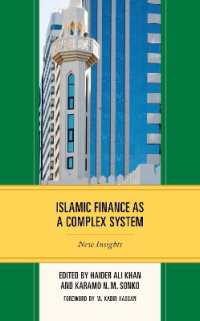Full Description
The Mongolian Empire, which reigned over the Eurasia Continent, was a great empire in the Middle Ages. Now, however, it is a divided nation, with a current population of about 10 million people, all of whom are distributed throughout the region, which makes contact with borders of the east, west, north, and south of (Outer) Mongolia. This book aims to offer a thrilling exploration of Mongolia's past, present, and future in the context of Mongolians in the 20th century.
This book details the region's historical development for the first half of the 20th century by tracing Mongolia's history with rare materials. In addition, the relationships between both Inner Mongolia and China, and Outer Mongolia and Russia, are analyzed in-depth. Then, accounting for the second half of the 20th century, the author offers an in-depth analysis of Inner and Outer Mongolia, which have changed greatly since the era of reform and their opening-up. These exciting analyses are based on field surveys conducted by the author every year since 1990.
Through synthesizing forty years of studies on Mongolia, including field surveys, the author analyzes the modern relationship between Inner Mongolia and Outer Mongolia, organized by subject and period. Also, the author argues that a unified Mongolia could become a serious threat to neighboring countries, such as China and Russia, in part because Mongolians are gathering under a spiritual leader named Chinggis Khan. Therefore, the question pursued in this book is: How can modern-day Mongolian achieve cohesion, thereby re-establishing a unified Mongolia? In response, this book argues that unification could be attained by linking Mongolia's economic development, political stability, and maintenance of cultural identity, and to do so based on "Chinggiskhanism" in a post-reform era. In this comprehensive 20th-century history of Mongolia, readers not only can come to understand why Mongolia became divided into two regions, Inner Mongolia and Outer Mongolia, but also readers will come to understand Mongolia's socio-cultural relationship with China. Truly, this book can serve readers as an opportunity to better understand the "development of relations for former glory between Mongolian peoples" based on the change in relationship between Inner Mongolia and Outer Mongolia after undergoing significant reforms and opening up.
Contents
List of Figures - List of Tables - Introduction - Independent Outer Mongolia and Chinese Autonomous Inner Mongolia (1911-1978) - The Reform and Opening-Up Policy in Inner Mongolia and Outer Mongolia, from 1978 to 1989 - A Turning Point of Fate for Inner and Outer Mongolia (the Tiananmen Square Incident in 1989 and the Outer Mongols Reform in 1990) - The Aftermath of China's Reform, Opening-Up, and Rise - Cultural Identity Issues - Conclusion - Epilogue - References - Index.








